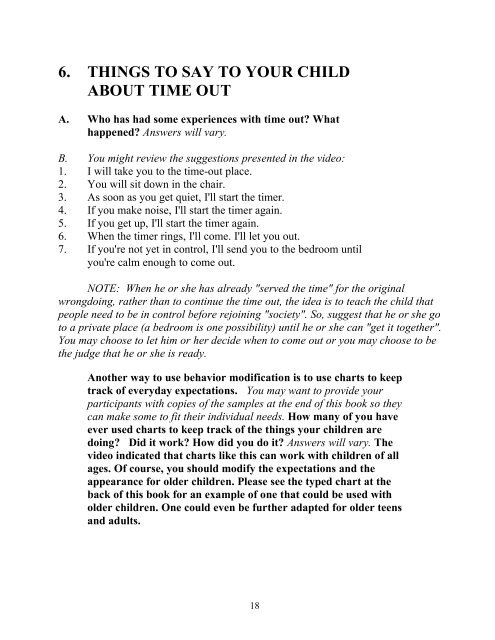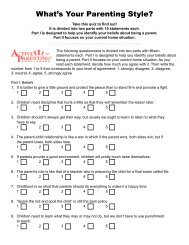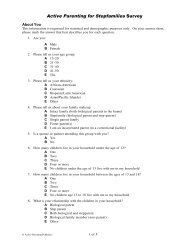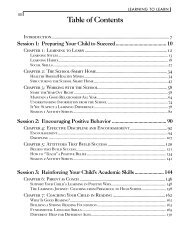Facilitator's Guide (download) - Active Parenting Publishers
Facilitator's Guide (download) - Active Parenting Publishers
Facilitator's Guide (download) - Active Parenting Publishers
You also want an ePaper? Increase the reach of your titles
YUMPU automatically turns print PDFs into web optimized ePapers that Google loves.
6. THINGS TO SAY TO YOUR CHILD<br />
ABOUT TIME OUT<br />
A. Who has had some experiences with time out? What<br />
happened? Answers will vary.<br />
B. You might review the suggestions presented in the video:<br />
1. I will take you to the time-out place.<br />
2. You will sit down in the chair.<br />
3. As soon as you get quiet, I'll start the timer.<br />
4. If you make noise, I'll start the timer again.<br />
5. If you get up, I'll start the timer again.<br />
6. When the timer rings, I'll come. I'll let you out.<br />
7. If you're not yet in control, I'll send you to the bedroom until<br />
you're calm enough to come out.<br />
NOTE: When he or she has already "served the time" for the original<br />
wrongdoing, rather than to continue the time out, the idea is to teach the child that<br />
people need to be in control before rejoining "society". So, suggest that he or she go<br />
to a private place (a bedroom is one possibility) until he or she can "get it together".<br />
You may choose to let him or her decide when to come out or you may choose to be<br />
the judge that he or she is ready.<br />
Another way to use behavior modification is to use charts to keep<br />
track of everyday expectations. You may want to provide your<br />
participants with copies of the samples at the end of this book so they<br />
can make some to fit their individual needs. How many of you have<br />
ever used charts to keep track of the things your children are<br />
doing? Did it work? How did you do it? Answers will vary. The<br />
video indicated that charts like this can work with children of all<br />
ages. Of course, you should modify the expectations and the<br />
appearance for older children. Please see the typed chart at the<br />
back of this book for an example of one that could be used with<br />
older children. One could even be further adapted for older teens<br />
and adults.<br />
18











